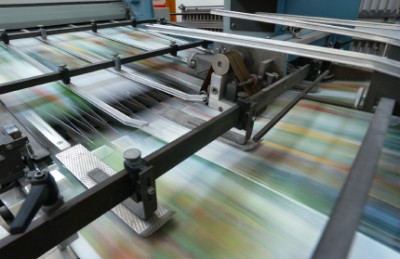
Why Does Paper for Political Direct Mail Printing Matter?
When it comes to political direct mail printing paper, there are as many choices as there are types of coffee drinks at your local Starbucks. Each paper type has specific characteristics that influence printability, color, texture, and price. Which option you choose depends on your budget, design, and overall goals.
Most political direct mail printing paper starts out as wood fiber-based, uncoated paper. Some paper stocks, such as a matte paper stock, leave the paper uncoated and provide a rougher feel that’s noticeable to the touch. If you’re doing a piece that has heavy ink coverage and full color photography in the design, often you will want to use a coated stock. To create coated stock, uncoated paper is coated with a white clay or filler material that’s calibrated to obtain a hard, smooth printing surface. Coated papers are less porous, allowing ink to sit better on top of the sheet, whereas uncoated paper is more porous, and the ink will be absorbed into the paper. The porous nature of the paper will have a huge influence on the final look and feel of the printed piece.
Within each paper type (coated or uncoated) there are myriad options in terms of color (bright white, cream, or various colors), brightness (from the brightest blue white to a dull gray white), texture (smooth finish to eggshell to specialty textures), opacity and general printability. There are also a different types of coating options. Gloss cover provides a glossy look and smooth feel, while something like a silk cover can provide you with a duller look and grainier feel. In terms of the price implications, while it may seem like it would be cheaper to use an uncoated paper, typically an uncoated stock is more expensive than a coated stock since its less commonly used.
There’s also a whole world of paper thicknesses to consider when choosing paper for your political direct mail printing. Paper thickness is determined by a number that indicates the pound. Two common thicknesses for political direct mail postcards are #80 and #100 (read as eighty pound and one hundred pound, respectively). Jumbo postcard sizes like 8.5 x 11s often do well with a thicker, more substantial paper stock like a #100. You may instead often choose a stock like a #80 that’s a bit thinner if you’re doing a piece that folds (folding a thicker paper can cause it to tear). Paper thickness can really matter when it comes to your political direct mail program, because you want your piece to seem substantial in the mailbox and stand apart from the other pieces that will have the consistency of a thin piece of regular home printer paper.
Even if you know that you like a certain paper stock, thickness, and cover type from your past political direct mailings, there’s some variation when it comes to paper brands, too. Paper brands can vary based on the region and the paper distributor, so it’s fairly common that two paper stocks with the exact same specs won’t be the exact same. Many printers will have what they consider to be their “house stock,” which is the type of paper they have readily available on their shop floor. If you’re using a printer for the first time and plan on using their house stock, we recommend that you have the printer ship out a sample so you can make sure it has the look and feel that you want.
There are also a few different “add-ons” you can get when it comes to political direct mail printing. For Democratic political direct mail, you often see a recycle bug, which indicates that the paper is recyclable. You can also choose to have a recycled paper stock, meaning it comes from paper that’s already been recycled. Within recycled paper stock, you even have a choice of the percentage of recycled paper that’s included, such as 100% recycled, 80% recycled, etc. But note that using a recycled paper instead of a recyclable paper stock will increase your costs.
So, what’s the right type of paper for your political direct mail printing? Well, it really depends on your goals and what the design will look like. Do you want a piece of mail with a local look and feel? In those instances, an uncoated, matte paper may serve you well, though it will cost a bit more. Do you have a visually stunning design with vibrant colors? A thick #100, coated glossy stock may work the best. Printing a piece for an environmental group? You may need to spring for a recycled paper stock. Depending on your printing needs, there is a paper type that will work best and provide the most successful end result.
Have other questions about political direct mail printing paper or other printing issues? Click here for more tips on producing great Democratic direct mail, or reach out to us at TCW Printshop or at The Campaign Workshop!